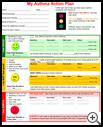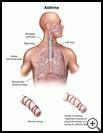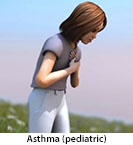
Status Asthmaticus
What is status asthmaticus?
Status asthmaticus is a severe asthma attack that does not respond to the usual treatment. Status asthmaticus is a medical emergency.
Asthma is a chronic (long-lasting) lung disease. It causes symptoms like coughing, wheezing, and shortness of breath.
Asthma symptoms are caused by two different problems in the airways.
- One problem is that the muscles in the airways tighten up, which causes the feeling of chest tightness and wheezing.
- The other problem is swelling, irritation, and too much mucus in the airways.
Asthma may be mild, moderate, or severe.
What is the cause?
If your child has asthma, symptoms often start after your child is exposed to a trigger. Asthma triggers can include:
- Exercise
- Allergies, such as dust, pollen, mold, or animal fur
- Something that irritates your child’s lungs, such as cold air, smoke, or strong smells like paint or perfume
- Medicines like aspirin or NSAIDs
- An infection such as a cold, the flu, or a sinus infection
- Strong emotions or stress
- Indigestion, also called gastroesophageal reflux disease, or GERD. If your child often has problems with acid indigestion, he may have more asthma symptoms, especially at night.
Children whose asthma is not well controlled are most at risk for status asthmaticus.
What are the symptoms?
Symptoms may include:
- Extreme trouble breathing
- Little or no breath sounds
- Inability to speak
- Bluish tinge to the skin or lips
- Heavy sweating
- Unconsciousness
Coughing and wheezing are common symptoms of asthma. However someone with status asthmaticus may not have enough airflow to be able to cough or wheeze.
The symptoms may develop over several days or weeks, or a severe attack may happen quickly.
How is it diagnosed?
A healthcare provider will ask about your child’s symptoms and medical history and examine your child. Your child will also have tests to measure the oxygen in the blood.
How is it treated?
Children with status asthmaticus need to be hospitalized. Some children need to be treated in a pediatric intensive care unit.
Your child will be given oxygen to increase blood oxygen levels. This is usually given through a face mask. Rarely a child will need a breathing tube inserted into their windpipe to help get air into the lungs. Your child will be treated with an inhaled or IV medicine to open the airways. Your child will receive steroid medicines and other medicines to reduce swelling and irritation, relax muscle spasms, and prevent mucus buildup.
How can I help prevent status asthmaticus?
Status asthmaticus is very serious, and you need learn what triggers are most severe for your child. It is important to avoid these triggers if at all possible and to get care quickly if you cannot avoid them.
Last modified: 2013-06-14
Last reviewed: 2016-05-11



